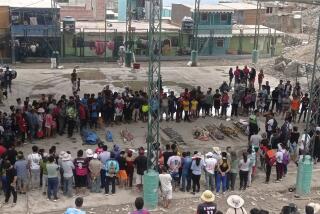Peru’s Colca Canyon, World’s Deepest Gorge, Emerging From Obscurity
COLCA CANYON, Peru — From a condor’s perch on this gorge in southern Peru you could look down on 10 of New York’s World Trade Center towers stacked end on end.
The 60-mile-long Colca Canyon formed by the Colca River is the deepest land gorge on Earth, according to the Guinness Book of World Records.
This mysterious land of desert-dry moonscapes, exotic vegetation, active volcanoes and scattered pre-Colombian ruins is just now emerging from obscurity.
The canyon and surrounding Colca Valley are home to thousands of Indians, descendants of pre-Inca tribesmen who settled here 3,000 years ago.
History in a Landscape
“The whole history of Peruvian man is summarized in this startling landscape, which until only a few years ago was incommunicado with the rest of Peru,” wrote the Peruvian novelist Mario Vargas Llosa in the foreword to the recently published “Discovering the Colca Valley,” one of the few books on the region.
Terraced fields painstakingly carved from the slopes still yield corn and potatoes, the Indians’ traditional staples. Ancient irrigation canals keep the land productive.
Some farms and hamlets rest precariously on canyon ledges, giving the appearance of defying gravity or tempting fate.
Most Indians still build their homes from adobe or rocks and rely on the wool of their alpaca herds for clothing.
They share these cloud-swept highlands with Andean condors and scores of rare flora and fauna, such as giant cacti and the guanaco, an elusive cousin of the llama.
14,339-Foot Drop
From surrounding mountain ridges, the Colca plummets 14,339 feet to the Colca River, according to Guinness. By comparison, the World Trade Center in New York is 1,350 feet high.
The opposing lower wall descends 10,607 feet, nearly double the depth of Arizona’s Grand Canyon.
Spanish conquistadors reached the Colca in the mid-1500s. They built churches and towns atop Indian villages and then left, said Mauricio de Romana, one of the authors of “Discovering the Colca Valley.”
Americans Robert Shippee and George Johnson led an expedition into Colca and published an article in the January, 1934, issue of National Geographic, calling it “a lost valley of the Incas.”
Opened Up by Gravel Road
It was a brief interlude in the obscurity of the Colca, whose wonders stayed forgotten until a gravel road was forged in the mid-1970s, linking it with Arequipa, 115 miles south.
Arequipa, Peru’s second-largest city, is 545 miles southeast of Lima.
“To the surprise of Peruvians and foreigners alike, this important setting, full of history and culture, appeared to the world,” Romana said in an interview.
The road brought change to the Indians’ traditional self-sufficient life style: tourists and spreading fame.
The Guinness book recorded the Colca’s depth for the first time in the mid-1980s, Romana said.
The road now carries travelers on a rugged five-hour journey in the shadow of the Andes’ majestic spine, across the barren and cold altiplano and skirting volcanic cones.
Bird’s Eye View From Rim
The canyon rim offers a bird’s eye view of walls plunging thousands of feet to the rushing Colca River and of condors gliding on thermal winds over farms and villages.
The most dramatic places are several days farther by foot and mule and are seen by just a hardy handful of the 10,000 to 15,000 tourists who reach the Colca yearly, according to Romana.
Anthony Holley, an Arequipa guide, said some visitors are discouraged because they cannot easily reach the deepest zone.
The arduous journey by road, a shortage of lodgings and generally unsafe conditions signal some of the major problems facing Peruvian tourism.
Spreading Chaos in Peru
In the last several years Peru has been hit by spreading social and economic chaos, fueled by its worst recession of the century.
Tourism officials say the country does not have the money to invest substantially in tourism infrastructure or even protect what already exists.
But officials say the Colca so far seems to have been spared from a recent upsurge in highway banditry and the bloody guerrilla insurgency plaguing many other areas of the country.
Romana, a director of the Colca Foundation, which seeks to preserve the zone, said the arrival of the modern world has not yet had a serious impact on the Colca or its people.
More to Read
Sign up for The Wild
We’ll help you find the best places to hike, bike and run, as well as the perfect silent spots for meditation and yoga.
You may occasionally receive promotional content from the Los Angeles Times.






